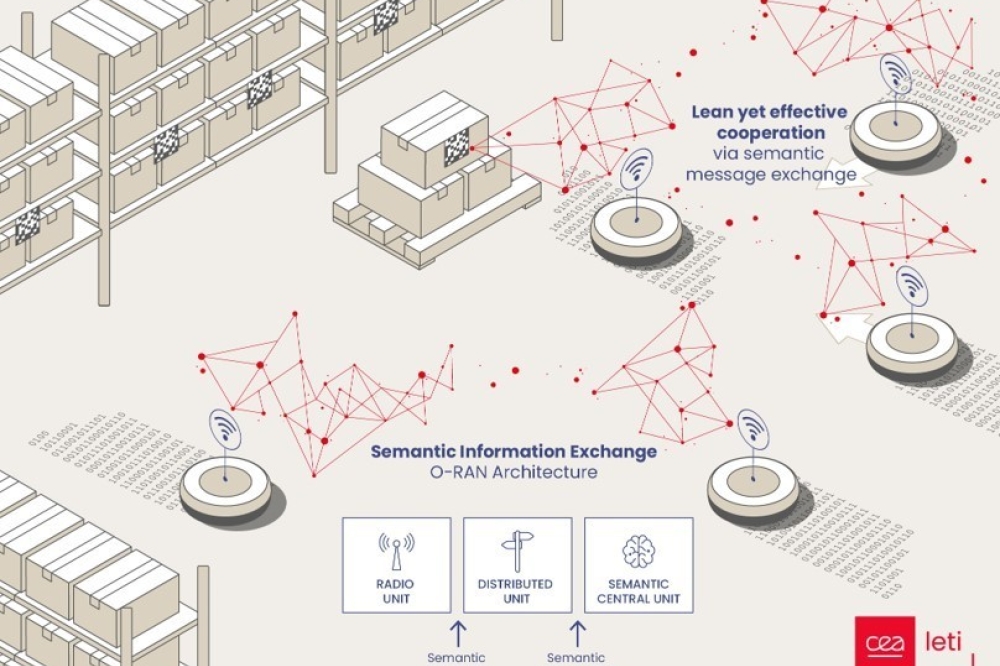CEA-Leti to coordinate 6G EU projects

6G-DISAC (Distributed Intelligent Sensing and Communication) and 6G-GOALS (Goal-Oriented AI-enabled Learning and Semantic Communication Networks) launched their three-year projects in January with multiple EU collaborators.
The two projects mark the first time a single RTO or company has been chosen to coordinate two competitive EU proposals in the same initiative. CEA-Leti has coordinated several EU projects, including the recently completed RISE-6G project. That SNS JU effort developed a disruptive new concept as a service for wireless environments by dynamically controlling wireless communication for brief, energy-efficient and high-capacity communications on a variety of surfaces, such as such as walls, ceilings, mirrors and appliances.
6G-DISAC
This project will develop and innovate on a widely distributed intelligent infrastructure compatible with both real-world integration constraints, new semantic and goal-oriented communication and sensing approaches, and the flexibility requirements of future 6G networks. It will apply theoretical approaches and operational and standards-compatible, distributed joint communication and sensing, by leveraging the expertise of world-leading network vendors, verticals, SMEs, research laboratories and academic institutions spanning the value chain.
Current approaches to integrated communication and sensing use centralized architectures and pass sensed information through a centralized controller.
“This project will bring the integrated sensing and communication (ISAC) vision into reality, going well beyond the usual restrictive standalone or localised scenarios, by adopting a holistic perspective, with large numbers of connected users and/or passive objects to be tracked,” said Emilio Calvanese Strinati, coordinator of the project and CEA-Leti’s smart devices & telecommunications strategy program director.
“With demonstrations that validate the vital 6G-DISAC concepts, the project will revolutionise various applications, from extended reality and robot-human interaction to vehicular-safety functions and improving communication key performance indicators (KPI) with sensing-aided communications,” he explained.
In addition to defining use cases and designing an innovative network architecture, the 11 6G-DISAC partners will develop novel physical-layer waveforms, distributed sensing and communications methods, optimised resource-allocation methods and protocols.
Specific targets include:
tracking connected user equipment (UE) and passive objects,
performing ISAC with many distributed base stations, efficient distributed signal processing and machine learning for semantic ISAC, and
incorporating extremely large multiple-input, multiple-output (MIMO) technologies and reconfigurable intelligent surfaces, and intelligent sensing activation.
“While addressing these fundamental and practical challenges, the team will focus on distributed implementation of ISAC, unlocking real sensing applications and providing a multi-perspective view of networks in space and time for tangible communication gains,” Calvanese Strinati said.
6G-GOALS
This project is designed to reduce data traffic by conveying only the most relevant information and produce data-efficient, robust and resilient protocols that can adapt to network conditions and communication objectives using modern AI/ML techniques.
“As wireless mobile communication requires ever-higher data rates and 5G’s scope expands to include massive and ultra-reliable low-latency links, wireless evolution has been pressed to solve the technical problem of reliable data exchange between two end-points,” said project coordinator Calvanese Strinati.
“The 6G-GOALS project will take the wireless system design to its next stage by considering the significance, relevance and value of the transmitted data and transforming the potential of the emerging AI/ML-based architectures into a semantic and goal-oriented communication paradigm, offering a solid step toward cooperative generative AI technologies,” he said.
Semantic communication is instrumental to induce reasoning and shared understanding among intelligent agents by exchanging pragmatically selected information in which its meaning to the receiver is designed to efficiently accomplish a goal or a task. With current approaches, data is sensed and transferred from sensors to the destinations without prior semantic extraction functions.
A recent paper written by 6G-GOALS participants noted that advances in AI technologies have expanded device intelligence, fostering federation and cooperation among distributed AI agents. These advancements impose new requirements on future 6G mobile network architectures.
“To meet these demands, it is essential to transcend classical boundaries and integrate communication, computation, control, and intelligence,” the paper, “Goal-Oriented and Semantic Communication in 6G AI-Native Networks: The 6G-GOALS Approach”, reports.
“These projects are fundamental to explore the capabilities of AI/ML solutions on the networks of the future, especially dealing with joint communication and sensing and semantic communications,” said Mauro Boldi Renato, EU project program coordinator at TIM (Telcom Italia). “Working with CEA-Leti represents a solid basis for their success and for bringing European industry towards implementation of 6G around 2030.”
“The exploitation of 6G-DISAC and 6G-GOALS project results will represent a transformative step for manufacturers and 6G industrial players, like NEC Corporation, by fostering the development of distributed intelligent networks and semantic/AI-driven communication strategies,” said Vincenzo Sciancalepore, principal researcher at NEC Laboratories Europe GMBH/ Germany and a member of the 6G-DISAC team. “Such an unprecedented approach will enable more efficient, flexible, and responsive network infrastructures that can support advanced applications, such as extended reality and automated mobility, meeting the increasing demand for high-capacity, low-latency and sustainable communication.”

































